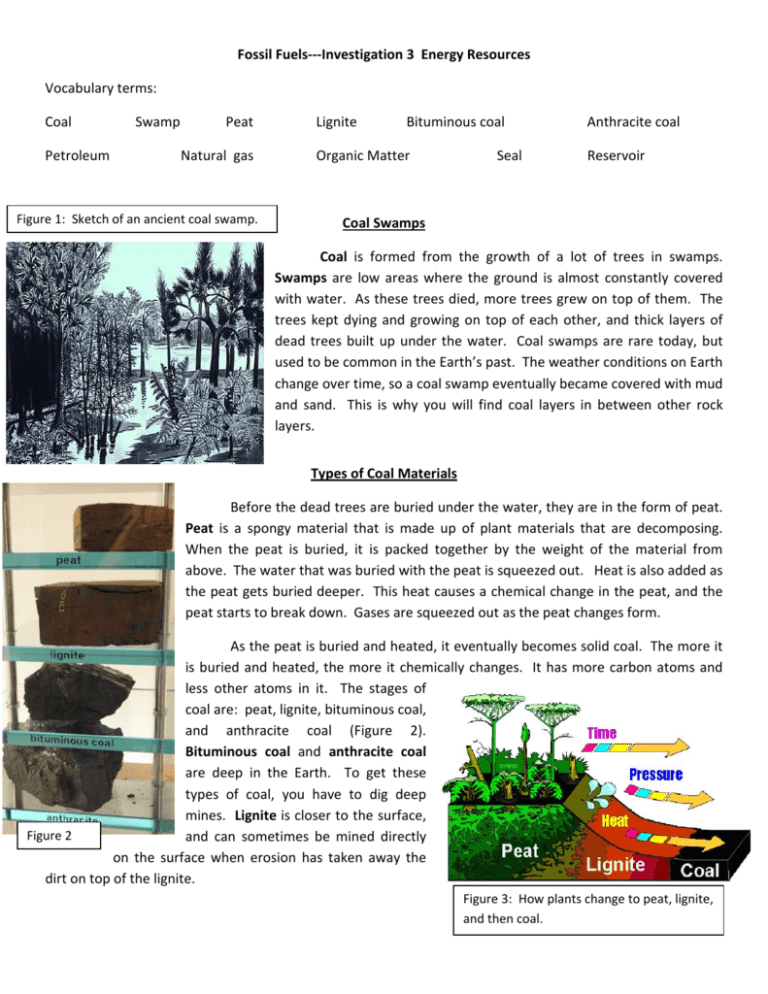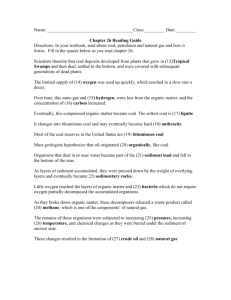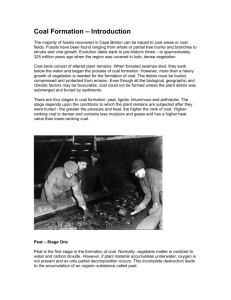Fossil Fuels---Investigation 3 Energy Resources Vocabulary terms
advertisement

Fossil Fuels---Investigation 3 Energy Resources Vocabulary terms: Coal Petroleum Swamp Peat Natural gas Figure 1: Sketch of an ancient coal swamp. Lignite Bituminous coal Organic Matter Seal Anthracite coal Reservoir Coal Swamps Coal is formed from the growth of a lot of trees in swamps. Swamps are low areas where the ground is almost constantly covered with water. As these trees died, more trees grew on top of them. The trees kept dying and growing on top of each other, and thick layers of dead trees built up under the water. Coal swamps are rare today, but used to be common in the Earth’s past. The weather conditions on Earth change over time, so a coal swamp eventually became covered with mud and sand. This is why you will find coal layers in between other rock layers. Types of Coal Materials Before the dead trees are buried under the water, they are in the form of peat. Peat is a spongy material that is made up of plant materials that are decomposing. When the peat is buried, it is packed together by the weight of the material from above. The water that was buried with the peat is squeezed out. Heat is also added as the peat gets buried deeper. This heat causes a chemical change in the peat, and the peat starts to break down. Gases are squeezed out as the peat changes form. As the peat is buried and heated, it eventually becomes solid coal. The more it is buried and heated, the more it chemically changes. It has more carbon atoms and less other atoms in it. The stages of coal are: peat, lignite, bituminous coal, and anthracite coal (Figure 2). Bituminous coal and anthracite coal are deep in the Earth. To get these types of coal, you have to dig deep mines. Lignite is closer to the surface, Figure 2 and can sometimes be mined directly on the surface when erosion has taken away the dirt on top of the lignite. Figure 3: How plants change to peat, lignite, and then coal. Where Coal is Found in the United States Figure 4 In the United States, you can find coal in many places (see Figure 4).. The Appalachian Mountains in the eastern United States contains most of the bituminous coal and almost all of the anthracite coal. This is where you find deep coal mines. You can also find coal in most of Illinois and Missouri. This coal can be surface mined. Lignite is found in the western United States. This is also surface mined. Petroleum (oil) and Natural Gas Formation Petroleum, also called crude oil, is a liquid made up of a mixture of carbon and hydrogen atoms. Natural gas is also made up of carbon and hydrogen atoms. Both petroleum and natural gas are formed deep in the Earth over a long period of time. Figure 5: Examples of the tiny sea plants and animals that die and eventually make up oil. Much of the ocean floor is covered with muddy sediments. In some places, these sediments contain a lot of organic matter. This organic matter is made up of tiny dead sea plants and sea animals (see Figure 5). These tiny plants and animals live at the surface of the ocean, but sink to the bottom when they die. They are then buried by sediment. As more and more sediment is layered on the ocean floor, the organic matter is buried deeper and deeper. As it gets buried deeper, the temperature rises from all the pressure on the organic matter. If the temperature increases in just the right way, the organic matter is changed into gas and oil. Petroleum and Natural Gas Reservoirs When the oil and gas are first created, they are just tiny drops or bubbles in the rock. These tiny drops rise upwards because they are less dense than water. Think about how it looks when you mix oil and water. Oil always floats on top. These droplets keep on rising until they get stuck under a thick rock layer that they cannot move through. This layer of rock is called a seal (see Figure 6). When we drill for oil and gas, we drill through this seal to pump out the oil or gas. This rock that contains the oil or gas underneath is known as a reservoir. Figure 6. See how the oil and gas form and then move (migrate) upwards until they reach the seal (non-porous rock). Porous means to have holes.






